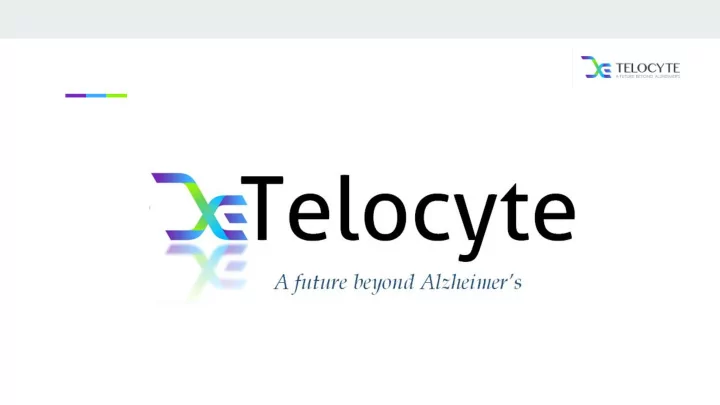

Summary Telomerase therapy will have a profound ► effect on age-related diseases We have good animal data ► We are proceeding to human trials ► Innovation always – and only - occurs when you change your assumptions.
Why Telocyte? Curing Alzheimer’s Disease (AD) ► 50 million Alzheimer’s patients globally ► $800 billion annual cost globally ► Brain aging and cell senescence are the ► primary causes of the disease and we have the technology to reverse both.
Primary Cause Telocyte approach for curing AD Telomere Shortening Target Telomere shortening ► Secondary Effects The primary cause of aging ► (Fossel, 2004) (López - Otín , Blasco, Partridge, Serrano, & Epigenetic Genomic Decreased Mitochondrial Increased Kroemer, 2013) changes instability Protein turnover dysfunction ROS/ATP Rejuvenate cells with Telomerase ► Reverses cell failure and resets gene ► Tissue Dysfunction expression, creating young, functional cells (Fossel, 2004) (Jaskelioff et al., 2010) Medical Outcome Proof of Concept ► Our collaborator, Maria Blasco, CNIO’s ► Clinical Disease Director, was the first to show telomerase gene therapy can safely extend healthy mouse lifespan by 24% and reverse behavioural decline without increasing cancer (Bernardes de Jesus et al., 2012) Untreated Treated
Telocyte approach for curing AD TEL-01 Glial Cell Aging Glial cell dysfunction as the primary cause of AD ► due to glia cell division causing cell aging (Boccardi, Pelini, Ercolani, Ruggiero, & Mecocci, 2015) β Amyloid Inflammation t Protein Mitochondria Oxidative stress Reverse cell aging by resetting gene expression ► Current trials (e.g., MAB’s) Glia have reduced β amyloid-binding, ► Neuron Death phagocytosis, and degradation with age Current drugs (e.g., donepezil) (Hickman, Allison, & Khoury, 2008) Alzheimer’s Disease
Telocyte approach for curing AD ► Our Product → Gene therapy drug candidate: Vector: Adeno-associated virus (AAV) ► Plasmid: Telomerase (hTERT and CMV) ► Target: Glial cells and neurons ► Delivery: IT (lumbar puncture, single dose) ► ► A modest investment can make a global difference
Telocyte Program Plan & Operating Budget ► Two-year quarterly Budget and detailed clinical Program
Management Team Founder, President Michael Fossel MD, PhD Dr. Fossel is the driving force behind Telocyte and has been the leader in proposing the use of telomerase to treat human disease for the past two decades. Clinical Professor of Medicine (retired), MD and PhD in Neurobiology from Stanford. Author of The Telomerase Revolution ( Wall Street Journal named it one of the best science books of 2015) and Oxford University Press textbook, Cells, Aging, and Human Disease . Founder, CEO Peter Rayson Peter T. Rayson is an experienced industry executive who provides leadership and business acumen for Telocyte. Engineering management with ComputerVision, working with Rolls Royce, Airbus, Ford, Jaguar Land Rover. Formerly Associate Director of the Technology Innovation Center at Birmingham City University, stepped down in 2011 when his mother was diagnosed with dementia COO Mark Hodges Mark Hodges is an experienced technology executive who provides effective and inspiring leadership for all Telocyte programs and services. Aerospace, defense, CAD business development, including at ComputerVision with Peter Rayson. General Manager of China Operations, managed 500 engineers across 15 offices for PTC Inc., a listed Boston engineering software firm.
Our Partnerships and SAB members Maria Blasco, PhD Zaven Khatchaturian, PhD Suzanne Hendrix, PhD Mimoun Azzouz, PhD Russell Swerdlow, MD Joseph Araujo, PhD
References Bernardes de Jesus, B., Vera, E., Schneeberger, K., Tejera, A. M., Ayuso, E., Bosch, F., & Blasco, M. A. (2012). Telomerase gene therapy in adult and old mice delays aging and increases longevity without increasing cancer. EMBO Molecular Medicine , 4(8), 691 – 704. https://doi.org/10.1002/emmm.201200245 Boccardi, V., Pelini, L., Ercolani, S., Ruggiero, C., & Mecocci, P. (2015). From cellular senescence to Alzheimer's disease: The role of telomere shortening. Ageing Research Reviews , 22, 1 – 8. https://doi.org/10.1016/j.arr.2015.04.003 Fossel, M. B. (2004). Cells, aging, and human disease . New York: Oxford University Press. Hickman, S. E., Allison, E. K., & Khoury, J. E. (2008). Microglial Dysfunction and Defective -Amyloid Clearance Pathways in Agi ng Alzheimer’s Disease Mice. Journal of Neuroscience , 28(33), 8354 – 8360. https://doi.org/10.1523/jneurosci.0616-08.2008 Jaskelioff , M., Muller, F. L., Paik, J. H., Thomas, E., Jiang, S., Adams, A. C., … DePinho, R. A. (2010). Telomerase reactivation reverses tissue degeneration in aged telomerase-deficient mice. Nature , 469(7328), 102 – 106. https://doi.org/10.1038/nature09603 López - Otín , C., Blasco, M. A., Partridge, L., Serrano, M., & Kroemer, G. (2013). The Hallmarks of Aging. Cell , 153(6), 1194 – 1217. https://doi.org/10.1016/j.cell.2013.05.039
Recommend
More recommend